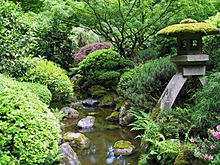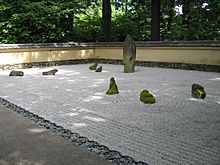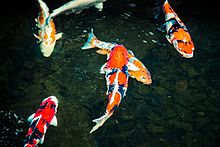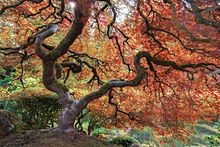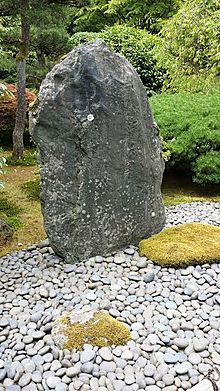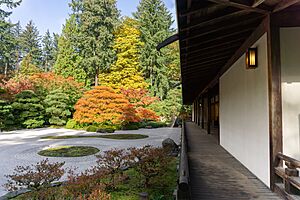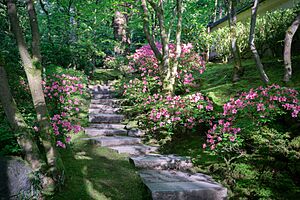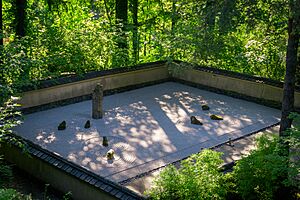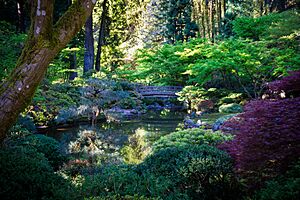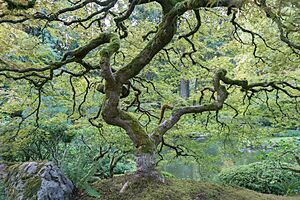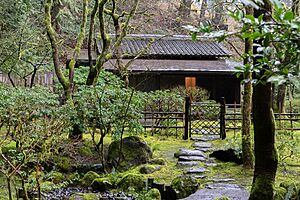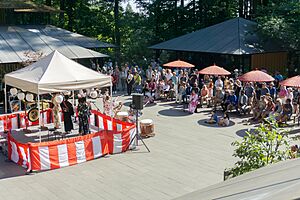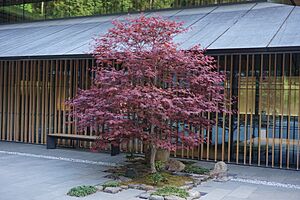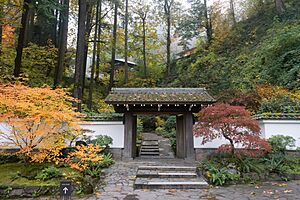Portland Japanese Garden facts for kids
Quick facts for kids Portland Japanese Garden |
|
|---|---|
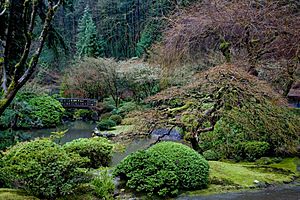 |
|
| Lua error in Module:Location_map at line 420: attempt to index field 'wikibase' (a nil value). | |
| Type | Japanese garden |
| Location | Portland, Oregon, United States |
| Area | 12.5 acres (5.1 ha) |
| Visitors | 400,000 (in 2024) |
| Status | Open to the public |
| Collections | Strolling Pond Garden Natural Garden Sand and Stone Garden Flat Garden Tea Garden Entry Garden Bonsai Terrace Tsubo-Niwa |
| Website | japanesegarden.com |
The Portland Japanese Garden is a special place in Portland, Oregon. It is a non-profit organization, which means it uses its money to help its cause, not to make a profit. The Garden opened to the public in 1967. It covers 12.5 acres (about 5 hectares) in Portland’s Washington Park. It is also right next to the International Rose Test Garden.
Professor Takuma Tono from Tokyo Agricultural University first designed the Garden. It has five unique garden areas. Each area shows a different style of Japanese landscape design. The Garden also has a Pavilion for art shows and shops. There is a traditional Japanese tea house and a "Cultural Village." This village offers programs, dining, and stores. Visitors walk through an Entry Garden after buying their tickets. More than 400,000 people visit the Portland Japanese Garden every year. Many people say it is the "most beautiful and authentic Japanese garden outside of Japan."
Contents
History of the Garden
The Portland Japanese Garden started in 1963. It was first called the Japanese Garden Society of Oregon. This is still its official legal name today. In 2023, the Garden celebrated its 60th anniversary.
How the Garden Began
After World War II, people in Portland wanted to rebuild friendships with Japan. In 1959, Portland and Sapporo in Japan became sister cities. This was a big step towards friendship. Building "friendship gardens" was another way to connect. Many cities in the United States did this.
People in Portland had wanted a Japanese garden since the 1950s. The idea grew stronger in 1959. The Japan Society of Oregon formed a Garden Committee. In 1961, they suggested creating a non-profit group. This group would plan and raise money for a Japanese garden. It would be built where the old Portland Zoo used to be in Washington Park. The City of Portland agreed to let them use the land for 99 years. In 1962, Mayor Terry Schrunk created a special commission. This group later became the Japanese Garden Society of Oregon. Their first meeting was in 1963.
Building the Garden in the 1960s
Professor Takuma Tono was hired to design the Garden in 1963. He was known for building a copy of Japan’s Ryoanji Garden. This was at the Brooklyn Botanic Garden. He suggested creating four different garden spaces. Each space would show a different style of Japanese garden design. These included a Flat Garden, a Strolling Pond Garden, a Dry Gravel Garden, and a Tea Garden.
In 1964, Kinya Hira became the Garden’s first Director. He was a student of Professor Tono. Since then, Japanese gardening experts have always overseen the Garden’s design.
The Garden opened in 1967 after about four years of building. Over 28,000 people visited that year. More additions were made later. In 1968, the Kashintei tea house was built in Japan. It was then taken apart, shipped, and put back together in the Garden’s Tea Garden. A fifth garden, a Moss Garden, was also built.
Changes in the 1970s
More updates were made to the Garden in the 1970s. The Moss Garden was changed into a Natural Garden. This style is called zoki no niwa. An "Antique Gate" was added at the bottom of the hill. This decade also saw the first koi fish arrive. The Garden also hosted its first annual O-Bon festival.
Japan’s Prime Minister Takeo Fukuda visited in 1978. He was very impressed by the Garden’s size and beauty.
Growth in the 1980s
In 1980, the Garden opened its Pavilion building. This building was planned from the start but was delayed. The opening ceremony was on May 18, the same day Mount St. Helens erupted.
In 1981, the Garden stayed open during winter for the first time. It has been open all winter ever since.
In 1988, Nobuo Matsunaga, Japan’s Ambassador to the United States, visited. He called the Garden "the most beautiful and authentic Japanese garden in the world outside of Japan." He also said it was a "unique treasure."
Updates in the 1990s
In the 1990s, an old zoo building was replaced. This new building became the Garden’s first Gift Shop. It is now the Membership Center.
In 1996, a Japanese water harp was installed. This happened during a meeting for Japanese gardens. The meeting was the first of its kind. It brought 200 people to Portland.
The 2000s and Beyond
In 2005, Steve Bloom became the Garden’s Executive Director. He retired in 2024 after leading the Garden for 20 years.
In 2008, the Garden started regular art exhibitions. These shows featured traditional and modern Japanese art. The first show was The Quiet Voice of Metal & Stone.
Expansion in the 2010s
In 2010, all the Garden’s past Directors came back for a reunion. They were all Japanese-born gardening experts.
Famous architect Kengo Kuma began work on expanding the Garden. This led to the opening of the Cultural Village in 2017. This new area has a small gallery, a café, a gift shop, classrooms, and offices.
In 2015, the Garden helped return parts of a Shinto shrine gate to Hachinohe, Japan. These parts had washed up on Oregon’s shores. They came from a 2011 tsunami in Japan.
Recent Years: The 2020s
In 2020, the Garden announced a new sister organization. It is called the Japan Institute. This group expands the Garden’s programs globally. It has held events in Tokyo, London, and New York. It has also donated stone lanterns to cities like Tokyo and Brooklyn.
Exploring the Garden Spaces
The Portland Japanese Garden first opened in 1967. It covered 5.5 acres (about 2.2 hectares). In 2017, it grew to its current size of 12.5 acres (about 5 hectares).
Historic Garden Areas
The Garden is sometimes called a "museum of gardens." This is because its five main areas each show a different style of Japanese garden design.
The Flat Garden
The Flat Garden (hira niwa) is a type of dry landscape garden. It uses flat ground, stones, and trimmed bushes. These elements create a feeling of depth. You are meant to view the Flat Garden from one spot. This is usually from inside the Pavilion building or its porch.
The Pavilion has been next to the Flat Garden since 1980. From its east side, you can see Portland city. Farther away, you can see Mount Hood. The Flat Garden also has a special "Iyo Stone." It honors Philip Englehart, the Garden’s first Board President.
The Natural Garden
The Natural Garden is in the zoki no niwa style. This design became popular in the mid-1900s. It replaced the old Moss Garden in the 1970s. This garden looks more like a forest than the others. It uses plants that are not as carefully trimmed. It has steps, small water areas, and a small resting spot called a machiai.
The Sand and Stone Garden
The Sand and Stone Garden is a karesansui, or dry landscape, garden. It has raked gravel partly surrounded by stucco walls. On the gravel are six medium-sized stones and one tall stone. Professor Tono, the original designer, said this garden can be seen in many ways. He suggested it could show a story about Buddha and seven tigers.
The Strolling Pond Garden
The Strolling Pond Garden shows the chisen kaiyu shiki teien style. It is the largest garden area. It has two ponds, a waterfall, a moon bridge, and a zig-zag bridge (yatsuhashi). There is also a hillside with cherry trees and stone lanterns. This style of garden was popular with nobles and feudal lords in Japan’s Edo period. Here are some special parts of this garden:
- The Heavenly Falls is a 35-foot-tall waterfall. It flows into a large pond with koi fish. This area used to be a bear cave when the Portland Zoo was here. The waterfall was damaged in 1997. It was rebuilt by Hoichi Kurisu, the Garden’s second Director.
- The Koto-Ji Lantern was a gift from the City of Kanazawa. It is a copy of a famous lantern in Kenroku-en, one of Japan’s most famous gardens.
- The Peace Lantern is a small stone lantern. The Mayor of Yokohama gave it as a gift in the 1950s. It was first in Portland’s International Rose Test Garden. It moved to the Japanese Garden in the 1960s. It has the words "Casting the Light of Everlasting Peace" carved into it.
- The Sapporo Pagoda Lantern was a gift from Sapporo to its sister city, Portland. It was first shown at the Portland Art Museum. This was while the Garden prepared the ground to hold its weight.
- “The” Tree is a Japanese maple tree. It became famous after being in a National Geographic photo contest. In the fall, when its leaves change color, photographers from all over the world come to see it.
The Tea Garden
The Tea Garden is in the roji style. This style became popular in the Momoyama and Edo periods. It has a path of stepping stones. This path leads to a tea house. The tea house is named Kashintei, which means "Flower-Heart Room." It was built in Japan in 1962. Then it was taken apart, shipped to Oregon, and put back together in the Portland Japanese Garden in 1968.
The Cultural Village
In 2017, the Portland Japanese Garden opened its new Cultural Village. This area has buildings and outdoor spaces. Architect Kengo Kuma and Sadafumi Uchiyama designed it.
Jordan Schnitzer Japanese Arts Learning Center
This is the largest building in the Cultural Village. It has several different areas:
- The Calvin and Mayho Tanabe Gallery is a small space for art shows. It displays both traditional and modern Japanese art.
- The Cathy Rudd Cultural Corner is a place for demonstrations and performances. These include Japanese gardening arts, tea ceremonies, and music. Visitors sit in the Jan Miller Living Room, which has staircase seating.
- The Gift Shop moved here in 2017. It sells many items, including some from Japan.
- The Vollum Library has over 3,000 books. These books are about Japanese gardens, art, and culture. In the middle of the library is a table made by George Nakashima.
- The Yanai Family Classroom is used for programs. These include talks, workshops, and gatherings.
The Ron and Jenny Herman Garden House
This building has the Family Studio. This space offers fun activities for children and their parents. The rest of the building is mostly offices.
Umami Café
The Umami Café hangs over a hillside. It serves green teas and small snacks. These include Japanese sweets and savory items like miso soup.
Ellie M. Hill Bonsai Terrace
This terrace is open all year. From mid-spring to fall, it displays a changing collection of bonsai trees. These trees are on loan to the Garden.
Jubitz Oregon Terrace
You can reach the Jubitz Oregon Terrace from the second floor of the Learning Center. It has a water feature. It also displays bonsai trees from mid-spring to fall.
Tsubo-Niwa
The tsubo-niwa is the smallest garden space. It is a small courtyard garden. It features a Japanese maple tree surrounded by moss.
The Entry Garden
The Entry Garden is the first area guests see after buying tickets. It is designed to be beautiful. It also helps slow down water flowing down the hillside. This was important after buildings were added to the hilltop.
Fun Programs and Events
The Portland Japanese Garden offers many different programs. These include:
- Art Exhibitions in its Pavilion and galleries. These shows feature Japanese art and design. Artists like Noritaka Tatehana have had their first U.S. shows here.
- Botanical Exhibitions of Japanese arts like ikebana (flower arranging) and bonsai.
- Classes and Workshops on topics like Japanese stitching, ikebana, kintsugi (repairing pottery), tree pruning, and bamboo fence building.
- Cultural Festivals celebrating important Japanese holidays. These include O-Shogatsu (New Year), Hina Matsuri (Doll Festival), Kodomo no Hi (Children’s Day), Tanabata (Star Festival), O-Bon (Spirit Festival), and Bon-Odori (Summer Festival).
- Demonstrations and Performances of cultural arts. These include bonsai, ikebana, tea ceremony, koto music, and shamisen.
- Lectures on Japanese topics. These often cover nature, art, culture, design, and history.
- Tours of the Garden. Some tours are just for members. There are also ASL-friendly tours and mindfulness tours.
Japan Institute: A Global Connection
The Japan Institute started in 2020. It is the part of Portland Japanese Garden that creates global programs. It has led many activities:
- Global Peace Symposia in cities like Tokyo, London, and New York. These events have talks, poetry, and discussions about nature, art, and culture.
- Artist Residencies where Japanese artists stay in Portland. They create art for exhibitions at the Garden. Rui Sasaski was the first Artist-in-Residence in 2023.
- Japanese Garden Seminars and Workshops through the Japanese Garden Training Center. This center teaches traditional and modern gardening methods.
How to Get Involved
You can become a member of the Portland Japanese Garden. As of 2025, an individual membership costs $70 per year. There are also other membership levels. All members can enter the Garden early every day it is open, from 8-10 am. The Garden also offers a "Moon Bridge Membership" for $20 per year. This is for families in Oregon and Southwest Washington who receive public assistance.
There are many ways to volunteer at the Garden:
- Bonsai Docents are at the Bonsai Terrace. They share information about the bonsai trees.
- Cultural Village Hosts greet people in the Cultural Village. They help visitors learn about the space and events.
- Exhibition Docents volunteer in the Pavilion Gallery. They teach visitors about the art shows.
- Event Volunteers help with larger programs and festivals.
- Garden Ambassadors give information about the Garden’s history and design. They also help visitors find their way around.
- Horticulture Support Volunteers work with the gardeners. They help keep the grounds beautiful by weeding, raking, and cleaning.
- Office Volunteers help with office tasks. This includes preparing mail and gift bags.
- Tour Guides lead tours of the Garden. They share detailed information about its history and design.
- Welcome Center Greeters talk to guests waiting in line. They help make sure visitors have a great experience.
More to Explore
- List of botanical gardens in the United States
- Lan Su Chinese Garden
- North American Japanese Garden Association
- Portland-Sapporo Sister City Association
See also
 In Spanish: Jardín Japonés de Portland para niños
In Spanish: Jardín Japonés de Portland para niños


